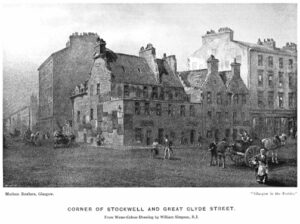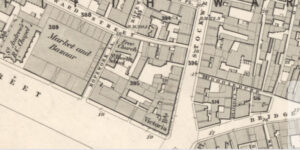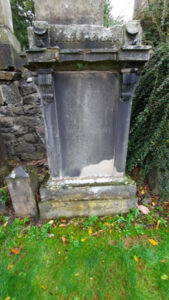James Menzies (1799-1844)
By Morag T Fyfe
In August 1820 adverts were placed in a number of newspapers offering a reward of 100 guineas (£105) for the capture of James Menzies.
ONE HUNDRED GUINEAS REWARD
ESCAPED FROM JUSTICE
WHEREAS, JAMES MENZIES, Herring Merchant and Fish Curer, lately residing in Jamaica Street of Glasgow, who stands charged with making FRAUDULENT INSURANCES, and PROCURING A VESSEL TO BE FELONIOUSLY SUNK AT SEA, and OF HAVING DEFRAUDED THE UNDERWRITERS, ESCAPED this morning from those who had him in custody, upon a warrant from the High Court of Justiciary,
A REWARD OF 100 GUINEAS
Is hereby offered to any person who shall give such information as may lead to his apprehension; the reward to be paid by Charles Stewart, Procurator Fiscal of the Justice of Peace Court, 71, Hutcheson Street.
The said James Menzies appears to be about 50 years of age, is a little pitted with the small pox, and freckled, has reddish whiskers, is about 5 feet 10 inches in height, [stout?] made, and speaks rather thick and quickly with a Highland accent.
Insurance Brokers and Underwriters who are in the knowledge of any particulars regarding insurances effected on the Brigantine Friends, to a voyage from Greenock, Port-Glasgow and Glasgow, to Hamburgh, in the year 1816, are requested to communicate them to Mr Stewart.
Glasgow, 2d August, 1820.
James Menzies and his co-accused, John M’Dougal were due to stand trial in the High Court of the Admiralty on 9th May 1821 but only John M’Dougal appeared and James Menzies, still on the run, was outlawed. Notwithstanding this set back, James Menzies was able to resume his life as a Glasgow merchant and, on his death in 1844, left his estate, both heritable and moveable, to establish four bursaries at Scottish universities (and to be buried in the Glasgow Necropolis).
Menzies and M’Dougal were accused of removing insured cargo from a barquentine called Friends before arranging for it to be sunk in the North Sea in 1816 and of defrauding the underwriters who insured the vessel and its cargo. M’Dougal’s trial proceeded in May 1821 resulting in his conviction and a sentence of transportation for life. Menzies remained at large until March 1823 when he was found in Lochee, Dundee living under the assumed name of James Murray. On 30th June he was put on trial on the original charge but the Solicitor-General, who was prosecuting, announced that due to the absence of an important witness (Daniel Bannatyne, mate of the Friends and a witness at M’Dougal’s trial in 1821) he would reluctantly have to give up the case. The prisoner was then dismissed from the bar, a free man.
James Menzies was born about 1779 according to best calculations though no birth/baptism record has survived to confirm this. His place of birth is likewise unknown but bearing in mind the emphasis he places on the parishes of Fortingall, Dull and Weem in north west Perthshire in his will it seems likely he was born in one of them. He moved to Glasgow as a young man, went into business as a grocer and was sufficiently established to marry Elgin Menzies (1780-1840) on 26th June 1801 in the new Gaelic Chapel opened in Duke Street in 1798. The Post Office directory of 1801 lists “Menzies, —-, grocer, Bridgegate” and in 1803 the entry is expanded to “Menzies, James, grocer, 98 Bridgegate” confirming James’s arrival in Glasgow.
Only one child is known to have been born to James and Elgin, a daughter Elizabeth c1805. She died from TB in 1840 three months after her mother and both are buried in the family lair in the Necropolis. Two further burials in the lair had been tentatively identified as a brother and sister of James. It turned out that although Thomas (c1782-1842) may be a younger brother of James, Jean Menzies, spinster, (c1772-1843) is a sister of his wife as she appointed her brother-in-law James Menzies her executor in her will. The last burial in the lair (Agnes Menzies) took place nineteen years after James’s death and looks more likely to be a niece. James certainly had Menzies nephews and nieces according to his 1837 will which also mentions nephews and nieces with the surnames of Forbes and Robertson, children of married sisters.
As stated previously James started trading from 98 Bridgegate first as a grocer and from 1816 as a herring merchant. Between 1817 and 1819 he can be found in Stockwell Street and then Jamaica Street before disappearing from the directories for a few years while on the run. In 1824 he returned to the listing as J Menzies & Co, herring merchants and from then until his death in 1844 he can be found at various addresses in Stockwell Street centred on number 116 and under various designations – herring merchant, fish curer, merchant, provision merchant. In 1821 during James’s time as an outlaw he was evidently regarded as a well-established and respected member of the Glasgow community as shown by the fact that nine merchants and fish curers of Glasgow supported his wife’s petition to the Crown regarding the unfortunate position he found himself in.

Corner of Stockwell and Great Clyde Street from William Simpson, Glasgow in the “Forties”. 1899 (Author’s collection)
The original sketch for this watercolour was made in 1846 (2 years after James’s death) and the view would have been very familiar to him. His own property lay just off view to the right. The corner building was replaced by the Victoria Buildings in 1854.
James and Elgin’s marriage in the Duke Street Gaelic Chapel in 1801 seems to mark the start of a close connection with the chapel as he appointed the current minister, Lewis Rose, to be one of the Trustees under his will of 1837. The managers of the chapel were also to receive a bequest of £50 for the benefit of the chapel funds. However only three months after the original will was signed in November 1837 James added a codicil to it in which he cancelled the appointment of Lewis Rose as one of his Trustees and the bequest of £50 to the chapel funds “having seen good and sufficient reasons for so revoking said legacy.” The most likely reason for James’s actions is that he was worried about the financial state of the chapel. In 1798 when Duke Street Chapel was built £3000 was borrowed to finance this and by 1837 only half of that sum had been repaid and the managers approached the Trades House of Glasgow hoping for a loan of £1200. The outcome of this approach is unknown but the subsequent history of the chapel suggests it was unsuccessful. The Disruption of 1843, the year before James died, resulted in a majority of the congregation leaving to form a Free Church congregation and the remaining members of the original congregation soon sank under the burden of the continuing debt until by 1851 the congregation dispersed and the church building lay in ruins. In happier times the congregation of the chapel had presented James with a walking stick which he bequeathed to John Menzies, innkeeper, Taybridge, [Aberfeldy?], Perthshire in his last codicil drawn up in August 1844 two months before his death. In that last codicil James appointed Rev James Boyd of the Tron Church as a Trustee showing his split with Duke Street Gaelic Chapel was complete.
One further personal detail about James to be found in his will is that by the time the last codicil was written his eyesight had deteriorated to such an extent that although the will was “subscribed by myself personally subscribing and also in furth corroboration thereof and on account of my rather imperfect writing caused by my blindness is subscribed by me through Notaries Public under named acting at my request at Glasgow the 2nd August 1844 … We James Hamilton jnr and John Monteith Notaries Public … in the premises and at the request of the above named and designed James Menzies who declares that he cannot write properly on account of blindness and after he had touched our pens respectively in token of his said request and our authority do hereby subscribe these presents for him the same having been previously read over to him in presence of us and the witnesses subscribing … “
Mention has been made previously that James Menzies left a will the main purpose of which was to establish four bursaries for students attending the Universities of Glasgow, Edinburgh or St Andrews after suitable provision had been made for his wife and other family members. His heritable estate comprising property in Stockwell Street, Glasgow made up the bulk of the potential capital. He owned wholly or had a share of three pieces of ground with the buildings thereon. The location of one piece of ground extending to 897 square yards which he bought from Mrs Hamilton Dundas in 1833 is unknown except for the general description ‘adjoining Stockwell Street’. It is clear from the descriptions of the other two pieces of ground that they adjoined each other on the west side of Stockwell Street, one plot of 295 square yards fronting Stockwell Street and the neighbouring plot of 434 square yards (of which Menzies owned ¾) immediately to its rear. These Stockwell Street properties remained in the hands of trustees until advertised for sale in the Spring of 1855.

Extract from Ordnance Survey 25” to the mile 1st edition. Lanarkshire VI 11 published 1860.
Reproduced with the permission of the National Library of Scotland
James Menzies’s property was located in the block in the centre of the image, facing on to Stockwell Street to the east and with access to Ropework Lane to the west and the unnamed Ropework Entry to the north.
The advert refers to one plot of roughly 1600 square yards, formerly belonging to James Menzies, which suggests that all three plots described above were, in fact, contiguous with one another. The property is presented as a prime development site being at the southern end of Stockwell Street close to Victoria Bridge with shops and dwelling houses facing onto Stockwell Street and vacant ground behind with separate access to Ropework Lane and Ropework Entry (later East Howard Street). Apart from the purchase in 1833 it is not known how James Menzies acquired his properties nor what price was paid for them when they were sold.
By 1861 the Menzies Bursaries were up and running, applications being made to Archibald Campbell, Camserney Cottage by Aberfeldy. The choice of candidates was governed by fairly standard conditions laid down by James Menzies in his will – firstly, members of his family, secondly, persons of the name of Menzies, thirdly, persons born on the estate of Sir Neil Menzies of Castle Menzies in the parishes of Fortingall, Dull or Weem. If none of these conditions could be fulfilled then the bursaries would be awarded to whichever of the applicants was best qualified. The Patrons of the scheme were to be Sir Neil Menzies, his heirs and successors and the Church of Scotland ministers of the three parishes. The bursaries are still available today.
No portrait of James Menzies is known but by drawing on such written sources as exist we can construct a picture of a tall, well built, freckled, red-headed Gaelic-speaking highlander. He was the centre of a large extended family comprising several sisters, a possible brother, a sister-in-law and numerous nephews and nieces for all of whom he made provision in his will. His last years were overshadowed by the loss of his wife and daughter within a few months of each other and his own deteriorating eyesight. It was not the loss of his wife and daughter that spurred him to set up his bursaries as he did so in 1837 while they were still alive.
A brief notice of James Menzies’s death on 7th October 1844 appeared in the local newspapers and he was buried by an unnamed nephew in the Necropolis on the 11th of the month. Puzzlingly James left his gravestone blank and if it wasn’t for his name at the top of the gravestone his burial place would be unidentified.
Acknowledgments
This profile would not have come about if Professor Aileen Fyfe and Dr Isabel Robinson, University of St Andrews hadn’t been curious about a fish curer in Glasgow.
Sources:
Scotlands People (scotlandspeople.gov.uk) for James Menzies’s Trust Disposition and Settlement (1844 SC36/51/20) and Inventory (1844 SC36/48/30); James’s entry in the 1841 census of Glasgow (644/1 34/ 15); James and Elgin Menzies’s marriage entry in the Old Parish Registers for Glasgow (1801 644/1 270 309); Jean Menzies’s Will (1843 SC 36/51/19)
Post Office directories of Glasgow
Scottish newspapers on www.britishnewspaperarchive.co.uk
Joan MacKenzie. The Highland community in Glasgow in the nineteenth century: a study of non-assimilation. Thesis submitted for the degree of Doctor of Philosophy at the University of Stirling. Department of History. October, 1987.










